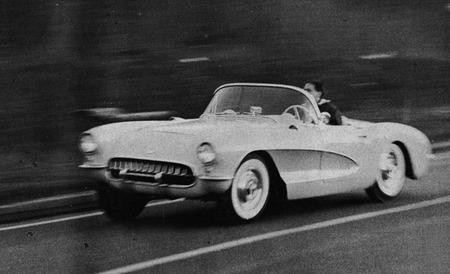It is in the handling department in particular that the Corvette proves itself the only true American production sports car. The steering is far from perfect but it is fast enough to allow right angles to be taken without removing the hands from the wheel, and this virtue will make up for many vices. The latter include an inch and a half of play, beyond which a strong caster action gives the wheel a springy feel. This little “no-man’s-land” in the middle causes some trepidation in tight spots. Once the wheel has been set for a bend, and the car has assumed an initial roll angle, the steering and throttle response are fast and consistent enough to allow very precise control.
Like most American cars this Chevrolet is a very strong understeerer, and requires a lot of helm to keep it on line in a bend. The stock rear end damping is a little weak; too much so to make a full-blooded drift a stable proposition. Cornering speeds and behavior were markedly improved by tire pressure five psi higher than the standard of 25 psi front and 27 psi rear. Raised pressures plus stiffer rear shocks could combine with an already broad track, good weight distribution, and low center of gravity to make the Corvette a real fiend on corners. These criticisms, it will be noted, are minor, and apply equally to many imported machines.
Of course, tire squeal is not entirely absent during these high-speed direction changes, but the car stays in the corner so there can be no real complaints. The Corvette is at its best on a winding open road, and, like the Jaguar, is dramatic but uncomfortable on a twisty back lane. The test car would have been much handier there if the driver had had more arm room and the optional seat belts. He tends to be thrown around more than necessary, but is not as conscious of the car’s roll angle as is the passenger.
Brakes are still by far the weakest link, and it must be admitted that they faded almost into oblivion during the performance tests. They recovered very quickly, though, and pulled the heavy car up with a minimum of slewing even when very hot. I sincerely feel that the substitution of harder Moraine linings or some of the foreign competition brands will improve high-temperature durability and perhaps modify the present spongy feel of the pedal. No power booster was fitted, and required pedal pressure was on the high side.
Very sensibly for a high speed car, the hood is hinged from the front, and opens well out of the way. The battery and brake master cylinder are easy to reach, and the small air cleaners ease access to the engine as a whole. Most awkward feature is the shielding for the ignition wiring, necessary to eliminate radio interference in a Fiber-glas body. Wingnuts quickly free these shields and bare the double-breaker distributor and all but the two left front spark plugs, which are tucked in behind the steering box.
The hydraulic system for the top mechanism is powered by a separate electric motor, which allows operation with the engine off and avoids direct absorption of any engine power. Individual motors operate the door windows.
Well finished and fitted, the trunk is usefully large for a sports car. All luggage must be removed to extricate the spare from its wooden-lidded compartment, which also houses the jack. One carrying feature of many imports that is missed in the Corvette is that handy space right behind the seats for coats, hats, lunches and other items that you don’t want to store in the trunk. In the Corvette you either live with them or lock them away.
In almost every respect, the 1956 Corvette is a very satisfying car on the highway, and supplements astonishing performance with a high level of roadholding. Even as it stands, power equipment and all, it has become a serious competitor for Jaguar in Production Class C, and this is by no means General Motors’ highest goal. In international events this year the car will be equipped with an optional cam providing 250 bhp at the sacrifice of present low-end smoothness. Also on the fire for either this or next year are engine boosts to 275 bhp, extensive use of light alloy in both body and chassis, and the development of suitable disc brakes by GM’s Moraine Division.
It seems likely that the standard Corvettes will remain much as they are, with work on the competition versions proceeding simultaneously as has been the case with Jaguar and their C and D models. Another two or three years could probably see a racing Corvette with as many standard parts as the D retains from the Jaguar line, shrouded in advanced coupe bodywork. GM will learn an incalculable amount from these cars, much of which will be passed on to the standard Corvette and to the passenger car. They’ve already learned quite a lot, as a matter of fact, most of which shows up in the all-around excellence of the 1956 Corvette.


Leave a Reply